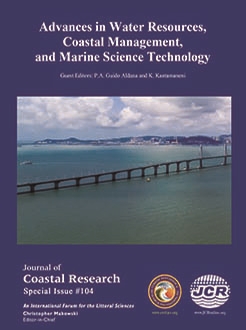Xu, G.; Liu, J.H.; Song, X.Y.; Tan, M.T.; Ren, H.W.; Li, D.N.; Tan, Y.H.; Huang, L.M., and Li, G., 2020. Diel rhythm in photosynthetic performance of phytoplankton assemblages is predicted to be light-dependent from in situ and mesocosm chlorophyll fluorescence. In: Guido Aldana, P.A. and Kantamaneni, K. (eds.), Advances in Water Resources, Coastal Management, and Marine Science Technology. Journal of Coastal Research, Special Issue No. 104, pp. 445–454. Coconut Creek (Florida), ISSN 0749-0208.
Marine physical and chemical changes caused by the ebb-and-flow of tide are well known to influence phytoplankton photophysiology; while it is unclear whether such changes affect the diel rhythm of phytoplankton photosynthesis. The diel changes of photosynthetic performance of phytoplankton assemblages were comparably explored from in situ and from two mesocosms in Daya Bay, northern South China Sea. The in situ Chl a content varied daily from 1.4 to 16.7 µg L-1 during the study period, but with a limited diel variation. The maximum photochemical quantum yield of Photosystem II (FV/FM) decreased from morning to noon, then increased till dusk, and maintained steady all night except for a sudden increase before next sunrise. Diel changes of electron transport efficiency (α) coincided with that of the FV/FM in daytime, but not in nighttime. The absorption cross section for photochemistry of Photosystem II (σPSII) varying from 4.1 to 7.7 nm-2 showed a similar diel change as that of the FV/FM. Diel changes of non-photochemical quenching (NPQ), saturating irradiance (EK) and maximum relative electron transport rate (rETRmax) mirrored the change of solar irradiation, with the highest and lowest values occurred at midday and midnight, respectively. The σPSII in surface and 3.5 m layers showed similar diel change pattern and had insignificant difference between the σPSII values. Moreover, all the photosynthetic parameters (i.e., FV/FM, σPSII, NPQ, α, EK and rETRmax,) from in situ showed the same diel change patterns as those from mesocosms, indicating the influence of tide-induced physical and chemical changes is limited. These results indicate that the diel rhythm in photosynthetic performance of natural phytoplankton assemblages is mainly available-light dependent.





